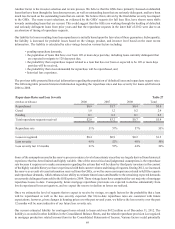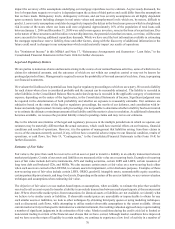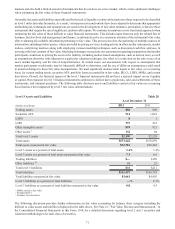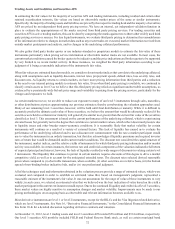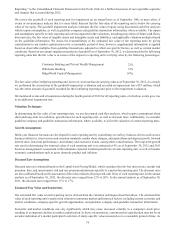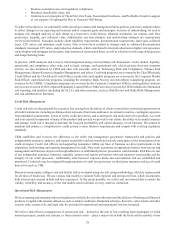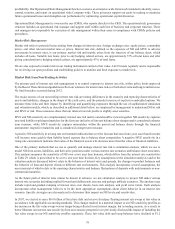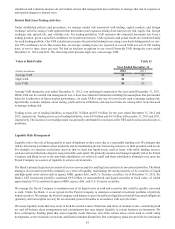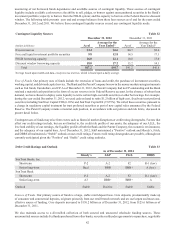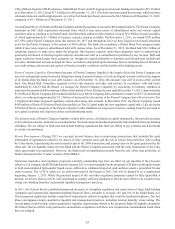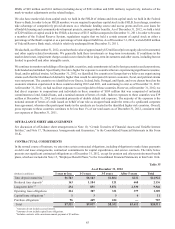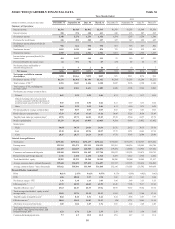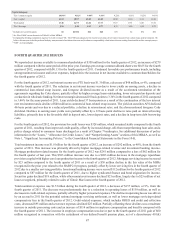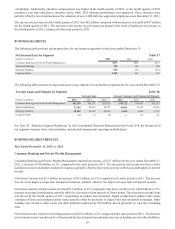SunTrust 2012 Annual Report Download - page 94
Download and view the complete annual report
Please find page 94 of the 2012 SunTrust annual report below. You can navigate through the pages in the report by either clicking on the pages listed below, or by using the keyword search tool below to find specific information within the annual report.78
• Promote sound processes and regulatory compliance;
• Maximize shareholder value; and
• Conform to our principles of Client First, One Team, Executional Excellence, and Profitable Growth in support
of our purpose of Lighting the Way to Financial Well-Being.
To achieve this objective, we continually refine our risk governance and management limits, policies, processes, and procedures
to reflect changes in our operating environment and/or corporate goals and strategies. In terms of underwriting, we seek to
mitigate risk through analysis of such things as a borrower's credit history, financial statements, tax returns, cash flow
projections, liquidity, and collateral value. Additionally, our loan products and underwriting elements are continuously
reviewed and refined. Examples include: client eligibility requirements, documentation requirements, loan types, collateral
types, LTV ratios, and minimum credit scores. Prior reviews have resulted in changes such as enhanced documentation
standards, maximum LTV ratios, and production channels, which contributed to material reductions in higher-risk exposures,
such as higher-risk mortgage, home equity, and commercial construction loans, as well as a decline in early stage delinquencies
and nonperforming loans.
In practice, CRM measures and oversees risk management along several primary risk dimensions: credit, market, liquidity,
operational, and compliance; other risks, such as legal, strategic, and reputational risk, which can arise from any corporate
activity, are also monitored by CRM and other risk stewards, such as Technology Risk and Compliance; Finance Risk
Management; Human Resources; Supplier Management, and others. Credit risk programs are overseen by the Chief Wholesale
Credit Officer and the Chief Retail Credit Officer; market risk and liquidity programs are overseen by the Corporate Market
Risk Officer; operational risk programs, including the enterprise Bank Secrecy Act/Anti-Money Laundering program, are
overseen by the CORO; Compliance programs are overseen by the Corporate Compliance Officer; and regulatory relations
activities are overseen by the Corporate Regulatory Liaison Officer. Other activities overseen by CRM include risk information
and reporting; risk analytics (including the ALLL); and other assurance, such as, Risk Review and Model Risk Management,
and risk administration functions.
Credit Risk Management
Credit risk refers to the potential for economic loss arising from the failure of clients to meet their contractual agreements on
all credit instruments, including on-balance sheet exposures from loans and leases, investment securities, contingent exposures
from unfunded commitments, letters of credit, credit derivatives, and counterparty risk under derivative products. As credit
risk is an essential component of many of the products and services we provide to our clients, the ability to accurately measure
and manage credit risk is integral to maintain the long-run profitability and capital adequacy of our business. We commit to
maintain and enhance a comprehensive credit system to meet business requirements and comply with evolving regulatory
standards.
CRM establishes and oversees the adherence to the credit risk management governance frameworks and policies and
independently measures, analyzes, and reports on portfolio and risk trends and actively participates in the formulation of our
credit strategies. Credit risk officers and supporting teammates within our lines of business are direct participants in the
origination, underwriting, and ongoing management of credit. They work to promote an appropriate balance between our risk
management and business objectives through adherence to established policies, procedures, and standards. Risk Review, one
of our independent assurance functions, regularly assesses and reports on business unit and enterprise asset quality and the
integrity of our credit processes. Additionally, total borrower exposure limits and concentration risk are established and
monitored. Credit risk may be mitigated through purchase of credit loss protection via third party insurance and use of credit
derivatives such as CDS.
Borrower/counterparty (obligor) risk and facility risk is evaluated using our risk rating methodology, which is implemented
for all lines of businesses. We use various risk models to estimate both expected and unexpected loss, which incorporates
both internal and external default and loss experience. To the extent possible, we collect and use internal data to ensure the
validity, reliability, and accuracy of our risk models used in default, severity, and loss estimation.
Operational Risk Management
We face ongoing and emerging risks and regulations related to the activities that surround the delivery of banking and financial
products. Coupled with external influences such as market conditions, fraudulent activities, disasters, cyber attacks and other
security risks, country risk, and legal risk, the potential for operational and reputational loss has increased.
We believe that effective management of operational risk – defined as the risk of loss resulting from inadequate or failed
internal processes, people and systems, or from external events – plays a major role in both the level and the stability of our



